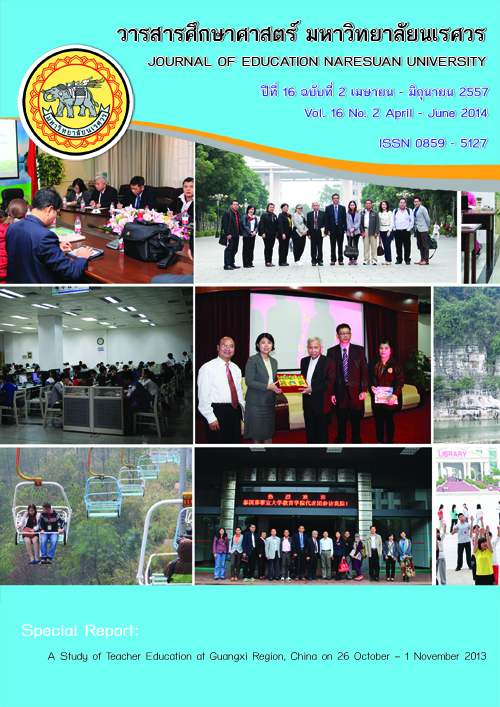การเปรียบเทียบผลสัมฤทธิ์ทางการเรียน เรื่อง หลักธรรมทางพระพุทธศาสนาของนักเรียนชั้นประถมศึกษาปีที่ 6 โดยการใช้วิธีสอนแบบ 4 MAT
Main Article Content
Abstract
บทคัดย่อ
การวิจัยครั้งนี้มีความมุ่งหมายเพื่อ 1) เปรียบเทียบผลสัมฤทธิ์ทางการเรียนก่อนเรียนกับหลังเรียนโดยการใช้วิธีสอนแบบ 4 MAT 2) เปรียบเทียบผลสัมฤทธิ์ทางการเรียนก่อนเรียนกับหลังเรียน โดยการใช้วิธีการสอนแบบโยนิโสมนสิการ 3) เปรียบเทียบผลสัมฤทธิ์ทางการเรียนระหว่างการใช้วิธีสอนแบบ 4 MAT กับวิธีการสอนแบบโยนิโสมนสิการ 4) ศึกษาความพึงพอใจต่อการเรียน ของนักเรียนกลุ่มที่ใช้วิธีสอนแบบ 4 MAT และกลุ่มที่ใช้วิธีการสอนแบบโยนิโสมนสิการ และ 5) เพื่อเปรียบเทียบความพึงพอใจต่อการเรียน ของนักเรียนระหว่างการใช้วิธีสอนแบบ 4 MAT กับวิธีการสอนแบบโยนิโสมนสิการ กลุ่มตัวอย่างที่ใช้ในการวิจัย ได้แก่ นักเรียนชั้นประถมศึกษาปีที่ 6 กลุ่มโรงเรียนเก้าสุพรรณิการ์ อำเภอบางปลาม้า จังหวัดสุพรรณบุรี ภาคเรียนที่ 1 ปีการศึกษา 2556 ได้มาจากการสุ่มอย่างง่าย (simple random sampling) จาก 15 โรงเรียนจับสลากได้โรงเรียนวัดโพธิ์ตะควน จำนวน 24 คน แล้วทำการจับสลากอีกครั้งเพื่อแบ่งกลุ่มทดลองจำนวน 2 กลุ่ม จำนวนกลุ่มละ 12 คน กลุ่มทดลองที่ 1 ใช้วิธีสอนแบบ 4 MAT และกลุ่มทดลองที่ 2 ใช้วิธีสอนแบบโยนิโสมนสิการ เครื่องมือที่ใช้ในการวิจัยได้แก่ 1) แผนการจัดการเรียนรู้แบบ 4 MAT 2) แผนการจัดการเรียนรู้แบบโยนิโสมนสิการ 3) แบบทดสอบวัดผลสัมฤทธิ์ทางการเรียนเรื่อง หลักธรรมทางพระพุทธศาสนา มีค่าความเชื่อมั่นเท่ากับ 0.790 และ 4) แบบสอบถามความพึงพอใจต่อการเรียน วิเคราะห์ข้อมูลใช้ค่าเฉลี่ยส่วนเบี่ยงเบนมาตรฐาน สถิติการทดสอบที
ผลการวิจัยพบว่า
1. ผลสัมฤทธิ์ทางการเรียน เรื่อง หลักธรรมทางพระพุทธศาสนาของนักเรียนชั้นประถมศึกษาปีที่ 6 โดยการใช้วิธีสอนแบบ 4 MAT หลังเรียนสูงกว่าก่อนเรียน อย่างมีนัยสำคัญทางสถิติที่ระดับ .05
2. ผลสัมฤทธิ์ทางการเรียน เรื่อง หลักธรรมทางพระพุทธศาสนาของนักเรียนชั้นประถมศึกษาปีที่ 6 โดยการใช้วิธีการสอนแบบโยนิโสมนสิการ หลังเรียนสูงกว่าก่อนเรียนอย่างมีนัยสำคัญทางสถิติที่ระดับ .05
3. ผลสัมฤทธิ์ทางการเรียน เรื่อง หลักธรรมทางพระพุทธศาสนา ของนักเรียนชั้นประถมศึกษาปีที่ 6 ระหว่างการใช้วิธีสอนแบบ 4 MAT กับแบบโยนิโสมนสิการไม่แตกต่างกัน
4. ความพึงพอใจต่อการเรียน เรื่อง หลักธรรมทางพระพุทธศาสนาของนักเรียนชั้นประถมศึกษาปีที่ 6 กลุ่มที่ใช้วิธีสอนแบบ 4 MAT โดยภาพรวมมีความพึงพอใจอยู่ในระดับมาก และกลุ่มที่ใช้วิธีสอนแบบโยนิโสมนสิการ โดยภาพรวมมีความพึงพอใจอยู่ในระดับมาก
5. ความพึงพอใจต่อการเรียน เรื่อง หลักธรรมทางพระพุทธศาสนาของนักเรียนชั้นประถมศึกษาปีที่ 6 ระหว่างการใช้วิธีสอนแบบ 4 MAT กับแบบโยนิโสมนสิการไม่แตกต่างกัน
คำสำคัญ: หลักธรรมทางพระพุทธศาสนา/ วิธีสอนแบบ 4 MAT/ วิธีสอนแบบโยนิโสมนสิการ
Abstract
The objectives of this research were 1) to compare the learning achievement of students before and after being taught by 4 MAT method 2) to compare the learning achievement of students before and after being taught by Yonisomanasikran method 3) to compare the learning achievement of students being taught by 4 MAT and Yonisomanasikran methods 4) to study the learning satisfaction of students which had been taught by 4 MAT and Yonisomanasikran methods and 5) to compare the learning satisfaction of students which had been taught by 4 MAT and Yonisomanasikran methods. The sample drawn using simple random sampling from 15 schools was 24 Prathomsuksa 6 students in the kaosuphannika groups school of watphotakuan School, Bang Pla Ma District, Saraburi Province during the second semester of academic year 2013. And a sample were separated into two groups. Each group consisted of 12 students. Students in the first group were taught by 4 MAT method while the students in second group were taught by Yonisomanasikran method. The research instruments used in this research were 1) the 4 MAT learning plan 2) the Yonisomanasikran learning plan 3) the Buddhism principle study achievement test to a reliability of 0.790 and 4) the questionnaire used for asking the learning satisfaction. Means, standard deviation and t-test dependent were used to analyze the data.
The results from this study were as follow:
1. The learning achievement on a Buddhism principle study of Prathomsuksa 6 students after being taught by 4 MAT method was statistically significantly higher than that before at .05.
2. The learning achievement on a Buddhism principle study of Prathomsuksa 6 students after being taught by Yonisomanasikran method was statistically significantly higher than that before at .05.
3. The learning achievement on a Buddhism principle study of Prathomsuksa 6 students being taught between 4 MAT and Yonisomanasikran methods were undifferentiated.
4. The learning satisfactions on Buddhism principle study of Prathomsuksa 6 students being taught by 4 MAT and Yonisomanasikran methods were generally high.
5. The learning satisfactions on Buddhism principle study of Prathomsuksa 6 students being taught by 4 MAT and Yonisomanasikran methods were undifferentiated.
Key words: Principles of Buddhism/ Teaching by 4 MAT/ Teaching by YonisomanasikranArticle Details
The owner of the article does not copy or violate any of its copyright. If any copyright infringement occurs or prosecution, in any case, the Editorial Board is not involved in all the rights to the owner of the article to be performed.


